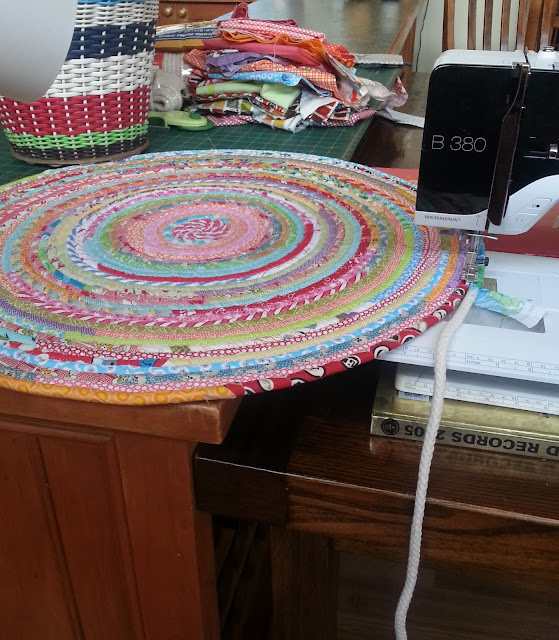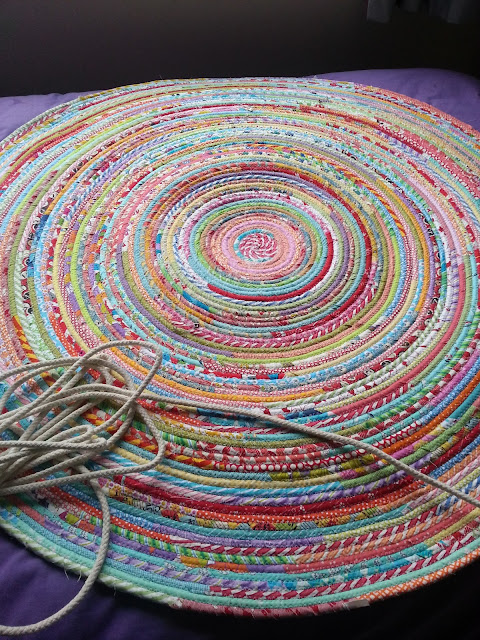Tuesday, June 3, 2025
Monday, April 10, 2023
How to sew a fabric rug : Tutorial
OK guys, now this is more of a marathon than a sprint (although it is super quick) so I think we need to organise ourselves before we start. Why ? because of course I jumped in feet first and fluffed up a few things and could have done them better so you guys get the benefit of my experience.
- Cotton sashing cord: I started with 8mm and had to really squeeze it under my presser foot. Once I ran out of 8mm I had to use 7mm - and it was much easier. You may need to see what your own machine is happy to cope with. My finished rug measures approx 47 inches across and I used 125 metres (almost 400 feet) of cotton sashing.
- Fabric strips: Any length x 1 1/4 inches wide. (Depending on my mood, I ripped some and cut some.) My strips varied between 1 and 2 inches but I found the narrower ones easiest to wrap. I have no idea how much fabric I used but my scraps are once more actually fitting in the scrap basket.
- Polyester Thread : Lots of thread - more thread than you can imagine. It is a good idea to pre-wind a stack of bobbins as well, because once you get started you are going to want to keep on going - it is highly addictive!
- Jeans needle: I started with a regular needle and broke one before commonsense kicked in and I switched to a jeans needle.
Machine settings:
I set my machine at the widest zigzag stitch possible and the stitch length at roughly the midpoint of what my machine offers.
If you look closely you can see, not only the zigzag stitch but also a straight stitch running the length of the cord. I began by stitching the length of the cord after I had wrapped it. I soon realised this was double handling and it wasn't really needed.
Joining:
I took this photo late at night so please excuse it.
I wrapped the end of the sashing in sticky tape (just one layer) and then cut it, tapering it to a kind of point. I covered the raw cut edge with a bit more tape and then wrapped it and sewed. A little spot of backtacking and the rug is done!
Note : My machine collected an amazing amount of lint during this project. I am not sure if it was the hours of sewing in one sitting, or something to do with the cotton sashing but it is worth your while to stop every few hours and remove the lint build up.
Thursday, July 14, 2022
Australian Designers Pattern Bundle - that's a mouthful !
You can even make them out of souvenir tea-towels !!!
Thursday, June 16, 2022
From the sublime to the ridiculous

Friday, June 3, 2022
Crunch
Look at those whiskers on the face of the dog that I collided with when I was checking the letter box this morning.
Look at the whiskers on the face of the dog that I fell over that then continued running and thought it was the greatest game.
I have officially reached the "does-not-bounce" stage of falling over in my life.
Friday, May 27, 2022
Soft 5
Friends, I'm trying but obviously still suck at popping in here.
I've been sewing, getting yelled at in supermarkets and making toast.
I was trawling the blog this morning looking for a photo that I know I have but apparently I also suck at naming photos. Some of these blog conversations feel like a lifetime ago. I have been reading old posts in that kind of happy sad way when something feels a long way away.
For example: This photo that is quite obviously of a pear shaped pincushion is
called "soft 5 ".
Sunday, April 3, 2022
Twig and Thistle
They are delightfully squishy and I just need to add noses to these two.
Speaking of noses...
This guy is patiently waiting for me to make a nasal choice.























